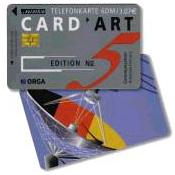Conductivity is Skin Deep

Ferroelectric materials can create an electric field the way iron magnets create a magnetic field. And because they’re so easily miniaturized, ferroelectrics are being used to permanently store data in a new generation of so-called smart cards, used for financial transactions in some countries. But condensed matter physicists still don’t fully understand how these promising materials work. When an isolated ferroelectric crystal becomes polarized (the electric field equivalent of “magnetized”), some decades-old theories predict that its surface should conduct electricity, even though the crystal itself is an insulator (nonconducting). Now a Japanese team reports in the 8 January PRL that they have finally verified this surprising prediction. But not all experts are convinced.
Researchers want to use ferroelectrics for data storage, but the materials have other properties that make them ideal for steering microscopic motions in ink jet printers and for detecting infrared light at room temperature. To develop the wide array of applications, they want to understand how ferroelectrics work.
You can polarize a ferroelectric crystal by heating it, placing it in a vertically oriented electric field, and then cooling it. Like a magnet, the crystal retains the polarization when the field is turned off. The transformation occurs because the external field nudges negatively charged atoms in the crystal slightly in one direction, while positively charged ones are pushed in the opposite direction. This process leaves the top and bottom surfaces with an excess of charge which attracts mobile electrons or holes. These mobile charges should make the surfaces conductive, but past experiments have failed to show any conductivity.
Yukio Watanabe and his colleagues at the Kyushu Institute of Technology in Japan prepared crystals with extremely clean surfaces and did all of their experiments in high vacuum, to avoid the complications that arise when the surfaces become even slightly contaminated. For each crystal, they affixed a pair of electrodes to the top surface and measured the current between them at a range of applied voltages. The conductivity across the top surface was 10 times higher when the crystal was positively polarized than when it was not polarized. At the same time, using a third electrode on the bottom face, they found that the volume of the crystal (the bulk) was insulating.
One problem with the paper, says Arkadi Levanyuk of Hewlett-Packard in Palo Alto, CA, is that, according to the paper’s text, the current vs. voltage curves did not show any drastic changes as the crystals were heated through the so-called Curie temperature of 130 degrees C, where the material loses its ferroelectric property. But J. Georg Bednorz of IBM in Zurich, Switzerland, says the Japanese team has done “a very careful analysis.”
David Vanderbilt of Rutgers University in New Brunswick, NJ, finds the results believable and even unsurprising, at least from a theoretical point-of-view. Watanabe and Bednorz agree that the work will help advance understanding of ferroelectric surfaces–a critical piece of the puzzle, as researchers try to exploit the materials in very thin memory devices.


